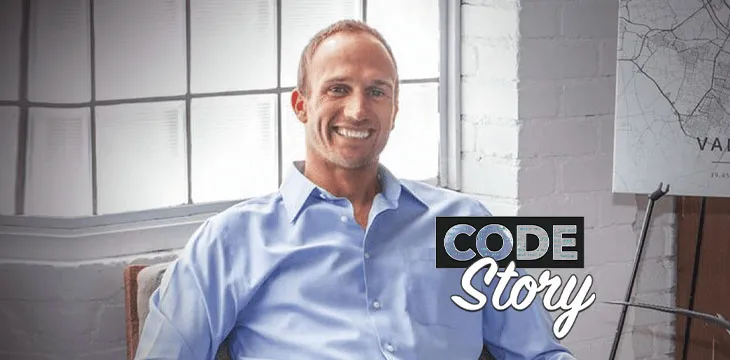|
Getting your Trinity Audio player ready...
|
Co-founder of Haste, Joe De Pinto, stopped by the Code Story podcast to talk about his company, Bitcoin SV, micropayments, and what Bitcoin is really all about.
The creation story of Haste Arcade
De Pinto’s story will be familiar to anyone in the BSV ecosystem. He and his partner, Dan Wagner, started Haste to demonstrate the utility of Bitcoin. Frustrated by the rampant price speculation and ignorance of the protocol’s potential to revolutionize things like payments, De Pinto and Wagner built an arcade to quickly and easily demonstrate to friends and family what Bitcoin was all about.
To showcase the power and potential of micropayments, the pair built an arcade with Instant Leaderboard Payouts. This means that players who finish in top positions on game leaderboards get a fraction of every payment made by players who fail to beat their high score. For the first time, arcade players could get more than just the satisfaction of seeing themselves as the top player; they could also get paid as long as they stayed on the leaderboard.
What was the first version of Haste Arcade like? What tools did they use to bring it to life?
De Pinto says that Wagner deserves a lot of credit for his work in the early days. He set about learning to code and eventually got good enough that they could create a minimum viable product.
Sitting in the office of their first venture, Barpay, they returned to the idea of the arcade and decided to create a “super simple, silly game” they could show people. The original game took Wagner a couple of hours to program. It was just a dot on the screen, and the player’s job was to tap it as fast as possible, with scores measured in milliseconds. The leaderboard was already in place, so players who finished with the fastest scores would get some payments made by subsequent players who failed to beat them.
The game immediately went viral, and De Pinto and Wagner spent a few days cleaning it up and improving the user interface. They’d gone from an idea to proof of concept within a week.
How did they progress and mature from that point? De Pinto says it’s slightly different from most startups in that they didn’t build it thinking it would become anything commercial; they were just having fun and testing their ideas about what Bitcoin could do.
However, about a week after they had released it, a VC company within BSV wrote about the game. They took the idea of the Instant Leaderboard Payout and applied it to Flappy Birds, a viral game that they estimated made the developers $50-$60,000 per day in ad revenue at its peak. They estimated that had they used the ILP; they’d have made over $2.5 million per day if people played at the half-penny level. The top player on the leaderboard would have been generating $250,000 per day in income.
De Pinto says this was a lightbulb moment. They realized there were some serious business use cases for it, and as an added benefit, it could eliminate the ads that nobody likes anyway. They talked to their investors at Barpay, and the lead investors were excited, so they put out a couple of simple games. At this point, they realized they needed some real talent to take this to the next level.
How did Haste build its team?
De Pinto says that, through their first venture, Barpay, they had relationships with some great developers. Eric DeForce, in particular, helped take things to the next level. He shared the idea with his twin brother, and they both loved it. They quit the firm they were working for and joined Haste full-time.
After the team was in place, the roadmap was developed. They decided on how to attract players, how to scale, what games to develop, and so on.
Did they build Haste to scale efficiently from day one, or are they figuring it out as they go?
De Pinto says they definitely did not build it to scale from day one. However, the blockchain they’re building on, BSV, is infinitely scalable.
He then delves into how miners need an incentive to keep mining the chain, and the block subsidy will not be enough to sustain them on BTC in the long run. By capping the amount of data they can put in a block, BTC has limited itself, while on BSV, an infinite amount of transactions can fit into each block. De Pinto and Wagner realized that BSV was the only blockchain that could handle the required volume of transactions that would last in the long game.
On Haste’s side, they not only had to build a good SDK, but the documentation also had to be excellent so casual game developers could understand it, De Pinto says.
What is De Pinto most proud of so far?
De Pinto says he’s most proud of the relationships the team has built. He’s been working with Wagner for more than 10 years, and they’ve been working with DeForce on multiple projects for seven years.
He’s also proud of Barpay and that it has survived for seven years. With Haste, he’s most proud of the Instant Leaderboard Payouts and the SDK around it. He sees so many potential applications for that in a blockchain-powered world, including outside gaming. He envisages ILPs being used in education and other fields.
“You can use it to gamify pretty much anything,” he says enthusiastically.
What mistakes have they made, and how did they respond?
De Pinto says they built out the arcade and were making micropayments. It didn’t add up to much, especially with employees on salary.
To bridge the gap, they released another product called Take It NFT. They wanted to let the market decide what the non-fungible tokens (NFTs) were worth, so users could come to the platform, decide to pay x for an NFT, and take it. When someone takes an NFT, the price automatically increases by 30%, so if someone spends $50, the next person who takes it from you pays more, giving you your original price plus a profit. Every time it gets taken, the price increases by 30%.
Since it launched in August last year, it has made as much as the Arcade made in a couple of years. De Pinto says this was a lesson: follow the money and demand sooner.
If he could go back to the beginning, what would he do differently?
De Pinto says he would have learned to program earlier, and he knows Wagner feels the same way. The days of cold-calling, traveling salesmen, and all of that are almost over—everything will be automated, and if you work in the technology space, you need to know how to code.
De Pinto doesn’t like to look back with regrets. He says we make the decisions we do at the time for a reason and learn from them. However, he would definitely learn to code sooner.
What advice would he give to fellow entrepreneurs? Be persistent. Yes, you can hit a home run, but there will be tough days and times, and that’s when you have to focus on being productive. Do what you can every day because, without persistence, you won’t make it.
Watch: Play2Earn with BSV Blockchain

 08-04-2025
08-04-2025 





